Real experience in implementing a gamification system at an internet marketing agency
Gamification is becoming more and more popular. In this post, I will tell you how the gamification system was implemented at Netpeak Internet marketing agency a few years ago, and how this system has grown to the current moment.
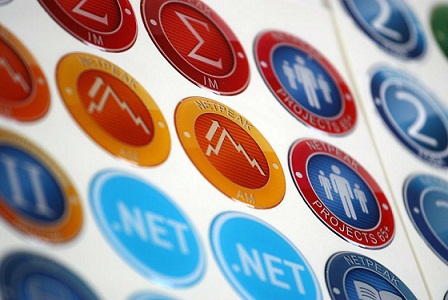
First, very briefly about the company in which the system was implemented: about 110 people work in Netpeak. The agency is focused on SEO and PPC. They will soon be 8 years old, two of which they are working on a gamification system, which will be discussed later in the article.
')
So, what is gamification?
Gamification is the introduction of gaming approaches to non-gaming processes.
Real life gamification example
It would seem that each of us understands that we need to play sports, that we need to run and walk in the fresh air. But most people find dozens of reasons for not doing this.
In this case, gamification comes to the rescue, with the help of which it becomes much more interesting to practice your health. A good example of gamification is the Jawbone UP bracelets, which are very popular among Netpeak employees.
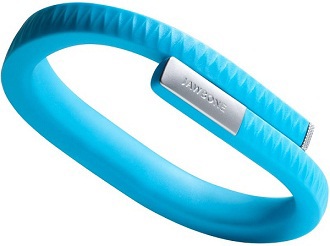
With the help of bracelets you can do the following:
1. Set yourself a goal and achieve it. For example, 10,000 steps a day that you need to go to feel awake. In this case, the number of completed steps (and the percentage of goal achievement) you can see at any time.
2. Receive badges for achieving good performance.
3. See the results of your friends with whom you want to compete and share achievements.
And all this in a perfectly drawn interface, with beautiful charts and graphs:

It would seem that the process of walking or running remains the same. But thanks to the introduction of gamification, it turns into an interesting game.
It’s not a fact that gamification can completely solve the problem of attention to one’s health (the bracelet tracks not only the steps, but also the owner’s dream) for all who try it. But we can confidently say that gamification is a great attempt to solve this problem.
____________________________
You can gamify almost any activity or process.
I spoke with Vladimir Polonik , who was involved in the development of the gaming system at Netpeak, and asked him to fully describe the process of implementing the system. Next with his words.
Netpeak's first gamification system (2012)
We thought carefully and chose two dozen metrics with indicators, upon reaching which employees will receive virtual medal awards. These medals, according to the established tradition, are called “badges” and they are displayed in the profile of each employee in our ERP system.
For example, such metrics were “Punctually to come to work,” “Maximum number of projects,” or “Increase in turnover per month.”
An important feature of badges is that they must look delicious. The badge should be a beautiful medal that you will want to get yourself.
Therefore, it is undesirable to leave awards in text form. It is much more effective to think over the design of these medals, with an emphasis on informativeness, to make it easier for employees to adapt at first. We made our badges like this:
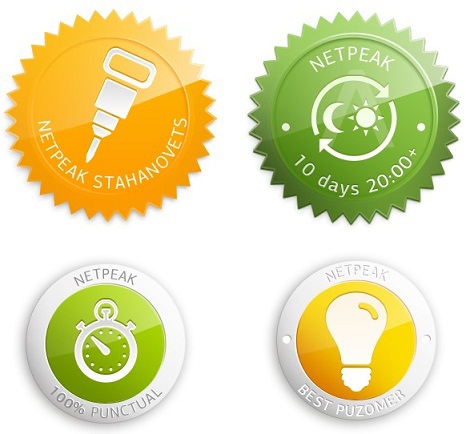
Our first gamification experiment allowed us to understand the following system flaws:
1. We began to give points for "age" achievements. Those. An employee could accumulate points simply because he worked for the company for a long time, even if he was lagging behind the younger employees.
2. On the one hand, there were badges, having received which, it was already impossible to lose them. For example, if a manager has ever received a badge “Turnover N thousand per month”, then the points for this achievement were taken into account forever, even if the turnover then fell. Such a system was unfair, since it was very difficult for beginners to overtake the “old men” who, in different periods of work, managed to get a large number of different badges.
3. On the other hand, there were a number of badges, for example, “Subbotnik”, which were temporary. This badge was issued to those employees who over the past 30 days were more than once at work on weekends. But if the next month the employee did not come on weekends, then the badge disappeared, and the employee did not have any memory of him. It was also unfair.
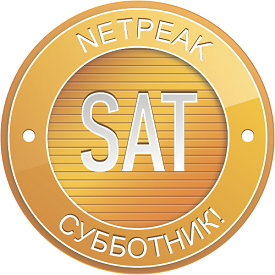
4. There was no clear system of informing and notifying employees about badges. Employees did not immediately find out that they had received a badge, and all the more so that the badge was received by their colleague.
The first system came out quite crude, so we began to refine it and think about solving the above problems.
System evolution
From 2012 to 2014, the system evolved, some badges were added, some, on the contrary, disappeared. So, for example, badges were added for employees who have worked a whole number of years at Netpeak:

One of the badges we removed was the “Wedding” badge.

Initially, we conceived it as a badge for those who entered into marriage while working in the company. But over time, we decided to bring all the badges to one, clearly described system. In this system, badges are given solely for actions that benefit the company. The wedding can not be called such an action, therefore, the badge has been removed from the system.
The system grew and developed. And 2 years after the launch of the system, we have prepared a big update for the employees. Using our corporate commitment to structuring, we gave our badges four properties:
1. Worker badges and badges for activity:
1.1. Work badges. This includes, for example, badges for speaking at conferences (and, the more an employee speaks, the higher his level is in this skill), badges for turnover in a quarter or for the best estimates received from a client in the Personal Account.

1.2. Badges for activity. Some of these badges are issued to employees for actions that do not directly benefit the company, but these actions still have a positive effect. For example, a badge for an employee who read the maximum number of books in the Netpeak library or became a star in the past corporate office of a company.

2. Badges, for which points (rating badges) are given, and “zero” badges:
2.1. The first are badges for which a different number of points is given. For important work achievements (for example, the maximum turnover on projects) is given up to 40 points. For less important achievements, in terms of the direct benefit of the company (for example, “10 conference presentations” or “Subbotnik”), 15 and 7 points are given, respectively.

2.1. The second (“zero”) are badges for which points are not given. These are badges for actions that only indirectly benefit the company. For example, badges for the number of years worked in the company, or for the best suit at corporate party.
3. Permanent and zeroable badges.
3.1. Permanent are those badges whose achievement will not need to be repeated anew. For example, it is enough to stick a Netpeak logo sticker on your personal car once to get the Avtopatriot badge, or just once to tattoo the company logo to get the Tattoo badge forever.
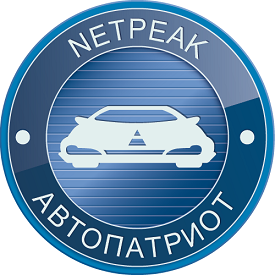
3.2. Badges must be re-confirmed. Because if an employee was successful in any indicator a year ago, it is not at all the fact that he is also successful in it now.
4. Automatic and "manual" badges:
4.1. We really love automation, so we tried to make the maximum possible number of badges automatic. The system checks whether the employee has met a certain criterion and automatically writes out a badge.
4.2. "Manual" badges are those badges that are manually written out by the HR manager. For example, the system will not be able to track itself whether the employee was in the support team at the last 8P conference or if the employee is a member of the corporate football team. In this case, HR personally issues the appropriate badges.

For example, we will show the properties of our two badges:

Netpeak's gamification system is an aggregation of all points for all the badges for all employees.
What further supports Netpeak's gamification system:
1. The overall rating of employees.
Employees receive points for badges, for finding bugs or proposing new ideas, for posts on the blog and for useful topics in the internal forum.
Employees can see this rating in several places at once - on the main page of our ERP system and on a large plasma in the corridor of our office.
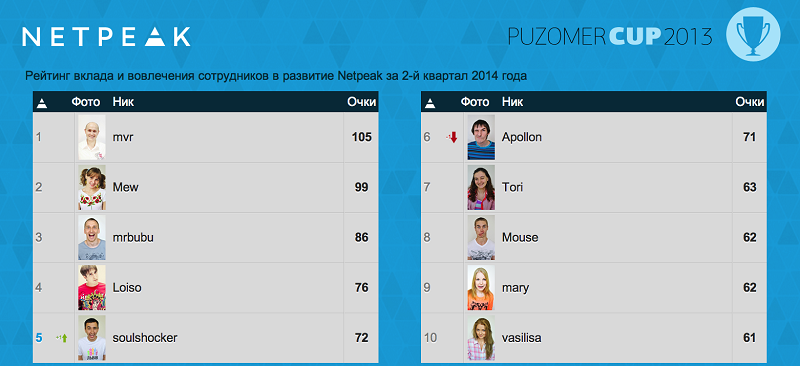
For the first three places, employees also receive badges, but no additional points are given for this:

The rating is updated quarterly, so every three months, employees have a new motivation to compete with each other:
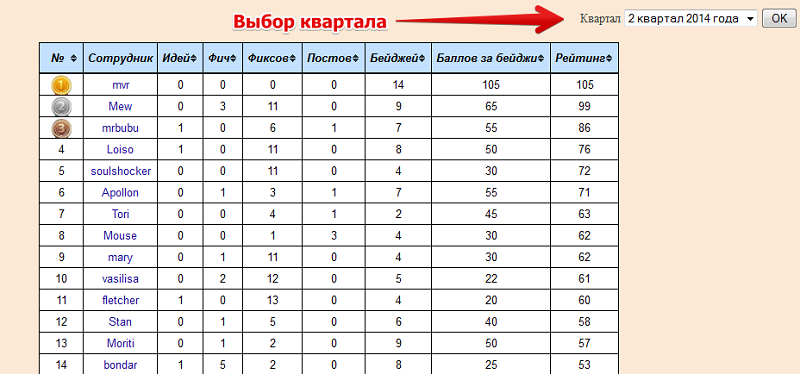
Of course, there are badges that are not reset, but remain with the employee from quarter to quarter. For example, if an employee brought three newcomers to the company, the “Recruiter-druzhinnik” badge will remain with him forever. As well as the "Tattoo" badge will be with the employee regardless of the quarter :)

By the way, there are already employees who received such a badge:

2. Track
In parallel, the rating also has a track system (by analogy with a racing track).
The employees of a number of roles on the main page of our ERP-system displays the track on which the vehicle is displayed. The higher the performance in the current quarter, the steeper the employee’s vehicle.
For example, this is how the track looks at the manager at the very beginning of the quarter. Increasing turnover, the manager begins to change to other vehicles. We see that very soon the manager will get a scooter:

Depending on the indicators, over time, he changes from a scooter to a bicycle, from a bicycle and a car, and so on to a jet plane.
If, for some reason, the employee starts to work worse, his vehicle “breaks down”, and this is immediately noticeable.
3. Alerts
In order not to lose informational content, it is necessary to inform employees that they have received a badge. To do this, we specifically display a personal notice to each employee.

and we inform about the new "badges" in the block with the morning greetings.
4. Information and rules
In addition, we have created a separate section in our internal Wikipedia, which is dedicated exclusively to gamification. It is there that describes the functions of our gamification system:

A complete list of badges with the criteria for their receipt, description and “value in points” is also given.

5. History of badges
In addition, we realized the dream of those employees who regretted the badges selected by the system.
Now we show the history of all badges received by the employee:

We go in profile to the employee and see that he now owns seven badges, and once before he had two more (they are displayed in black and white reduced copies).
This is what Artem Borodatyuk, Director of Netpeak, says about the system of gamification:

Monitoring the current system:
Of course, like most systems, our gamification system can be improved. We highlight two important points:
1. The balance of power. In Netpeak, there are different roles of employees, and the system measures all together. Accordingly, the programmer will not be able to become the best manager. Therefore, we sought to introduce unique badges for each of the roles. The system has become much more stable, but not yet perfect. Roles that produce basic services are more likely to receive more badges. For example, an internet marketer potentially has a greater variety of badges than an HR manager.
2. The system still requires significant human involvement. Approximately 65% of badges are issued automatically, but there are still 35% that need to be given out to employees manually. Those. the load on the HR department increases, but these are inevitable costs when implementing such a system.
We continue to monitor our system and improve it.
Offline badges
Finally, I’ll talk about another nice addition to our gamification system.
We recently did another update. We printed all our badges in the form of beautiful convex stickers and thereby brought gamification from the virtual to the real world.
In the morning, one spring day, employees came to work and found envelopes with nicknames on their tables.

In each envelope lay a set of badges possessed by the employee.
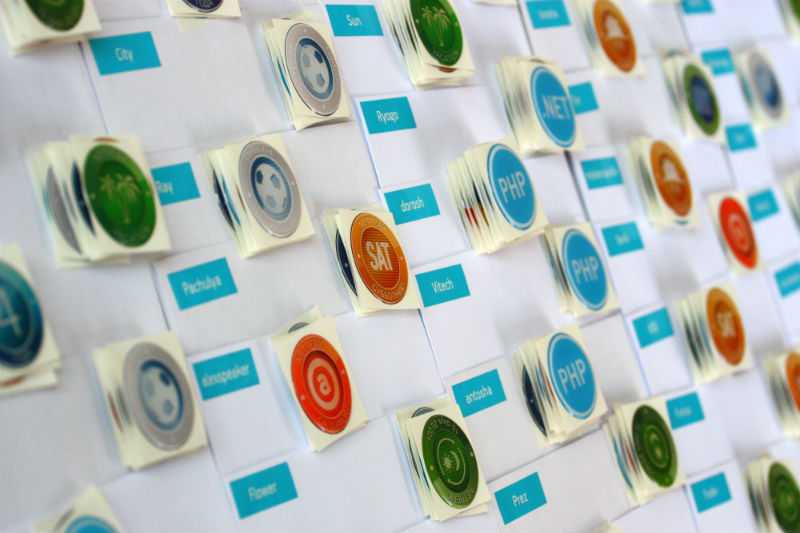
Now, each employee had the opportunity to stick badges on his laptop or monitor, so that they were visible to all other employees. Moreover, if the laptop in the future will be inherited by another employee, then the stickers, of course, will be removed. Badges are purely individual awards.
And netpikovtsy began to actively use this opportunity! Now at Netpeak, a unique working technique:
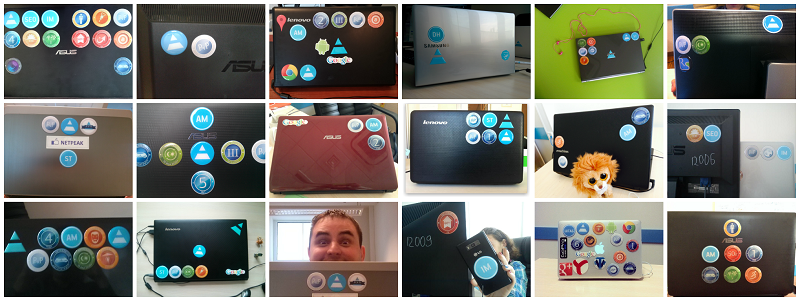
And what pleases the most - this gamification system really works! Many employees are very jealous of the situation when they did not take into account some of their merit and did not give out a badge. And some even come to work on weekends specially, not only to cope with a large amount of work, but also to receive honorary badges “Subbotnik” and “Stakhanovets”.
Of course, badges very rarely can play the role of the only motivation. But at the same time, they are always a pleasant and well-deserved reward for Netpeak employees :)
We will continue to improve and refine our gamification system, so until the next major updates!

First, very briefly about the company in which the system was implemented: about 110 people work in Netpeak. The agency is focused on SEO and PPC. They will soon be 8 years old, two of which they are working on a gamification system, which will be discussed later in the article.
')
So, what is gamification?
Gamification is the introduction of gaming approaches to non-gaming processes.
Real life gamification example
It would seem that each of us understands that we need to play sports, that we need to run and walk in the fresh air. But most people find dozens of reasons for not doing this.
In this case, gamification comes to the rescue, with the help of which it becomes much more interesting to practice your health. A good example of gamification is the Jawbone UP bracelets, which are very popular among Netpeak employees.

With the help of bracelets you can do the following:
1. Set yourself a goal and achieve it. For example, 10,000 steps a day that you need to go to feel awake. In this case, the number of completed steps (and the percentage of goal achievement) you can see at any time.
2. Receive badges for achieving good performance.
3. See the results of your friends with whom you want to compete and share achievements.
And all this in a perfectly drawn interface, with beautiful charts and graphs:

It would seem that the process of walking or running remains the same. But thanks to the introduction of gamification, it turns into an interesting game.
It’s not a fact that gamification can completely solve the problem of attention to one’s health (the bracelet tracks not only the steps, but also the owner’s dream) for all who try it. But we can confidently say that gamification is a great attempt to solve this problem.
____________________________
You can gamify almost any activity or process.
I spoke with Vladimir Polonik , who was involved in the development of the gaming system at Netpeak, and asked him to fully describe the process of implementing the system. Next with his words.
Netpeak's first gamification system (2012)
We thought carefully and chose two dozen metrics with indicators, upon reaching which employees will receive virtual medal awards. These medals, according to the established tradition, are called “badges” and they are displayed in the profile of each employee in our ERP system.
For example, such metrics were “Punctually to come to work,” “Maximum number of projects,” or “Increase in turnover per month.”
An important feature of badges is that they must look delicious. The badge should be a beautiful medal that you will want to get yourself.
Therefore, it is undesirable to leave awards in text form. It is much more effective to think over the design of these medals, with an emphasis on informativeness, to make it easier for employees to adapt at first. We made our badges like this:

Our first gamification experiment allowed us to understand the following system flaws:
1. We began to give points for "age" achievements. Those. An employee could accumulate points simply because he worked for the company for a long time, even if he was lagging behind the younger employees.
2. On the one hand, there were badges, having received which, it was already impossible to lose them. For example, if a manager has ever received a badge “Turnover N thousand per month”, then the points for this achievement were taken into account forever, even if the turnover then fell. Such a system was unfair, since it was very difficult for beginners to overtake the “old men” who, in different periods of work, managed to get a large number of different badges.
3. On the other hand, there were a number of badges, for example, “Subbotnik”, which were temporary. This badge was issued to those employees who over the past 30 days were more than once at work on weekends. But if the next month the employee did not come on weekends, then the badge disappeared, and the employee did not have any memory of him. It was also unfair.

4. There was no clear system of informing and notifying employees about badges. Employees did not immediately find out that they had received a badge, and all the more so that the badge was received by their colleague.
The first system came out quite crude, so we began to refine it and think about solving the above problems.
System evolution
From 2012 to 2014, the system evolved, some badges were added, some, on the contrary, disappeared. So, for example, badges were added for employees who have worked a whole number of years at Netpeak:

One of the badges we removed was the “Wedding” badge.

Initially, we conceived it as a badge for those who entered into marriage while working in the company. But over time, we decided to bring all the badges to one, clearly described system. In this system, badges are given solely for actions that benefit the company. The wedding can not be called such an action, therefore, the badge has been removed from the system.
The system grew and developed. And 2 years after the launch of the system, we have prepared a big update for the employees. Using our corporate commitment to structuring, we gave our badges four properties:
1. Worker badges and badges for activity:
1.1. Work badges. This includes, for example, badges for speaking at conferences (and, the more an employee speaks, the higher his level is in this skill), badges for turnover in a quarter or for the best estimates received from a client in the Personal Account.

1.2. Badges for activity. Some of these badges are issued to employees for actions that do not directly benefit the company, but these actions still have a positive effect. For example, a badge for an employee who read the maximum number of books in the Netpeak library or became a star in the past corporate office of a company.

2. Badges, for which points (rating badges) are given, and “zero” badges:
2.1. The first are badges for which a different number of points is given. For important work achievements (for example, the maximum turnover on projects) is given up to 40 points. For less important achievements, in terms of the direct benefit of the company (for example, “10 conference presentations” or “Subbotnik”), 15 and 7 points are given, respectively.

2.1. The second (“zero”) are badges for which points are not given. These are badges for actions that only indirectly benefit the company. For example, badges for the number of years worked in the company, or for the best suit at corporate party.
3. Permanent and zeroable badges.
3.1. Permanent are those badges whose achievement will not need to be repeated anew. For example, it is enough to stick a Netpeak logo sticker on your personal car once to get the Avtopatriot badge, or just once to tattoo the company logo to get the Tattoo badge forever.

3.2. Badges must be re-confirmed. Because if an employee was successful in any indicator a year ago, it is not at all the fact that he is also successful in it now.
4. Automatic and "manual" badges:
4.1. We really love automation, so we tried to make the maximum possible number of badges automatic. The system checks whether the employee has met a certain criterion and automatically writes out a badge.
4.2. "Manual" badges are those badges that are manually written out by the HR manager. For example, the system will not be able to track itself whether the employee was in the support team at the last 8P conference or if the employee is a member of the corporate football team. In this case, HR personally issues the appropriate badges.

For example, we will show the properties of our two badges:

Netpeak's gamification system is an aggregation of all points for all the badges for all employees.
What further supports Netpeak's gamification system:
1. The overall rating of employees.
Employees receive points for badges, for finding bugs or proposing new ideas, for posts on the blog and for useful topics in the internal forum.
Employees can see this rating in several places at once - on the main page of our ERP system and on a large plasma in the corridor of our office.

For the first three places, employees also receive badges, but no additional points are given for this:

The rating is updated quarterly, so every three months, employees have a new motivation to compete with each other:

Of course, there are badges that are not reset, but remain with the employee from quarter to quarter. For example, if an employee brought three newcomers to the company, the “Recruiter-druzhinnik” badge will remain with him forever. As well as the "Tattoo" badge will be with the employee regardless of the quarter :)

By the way, there are already employees who received such a badge:

2. Track
In parallel, the rating also has a track system (by analogy with a racing track).
The employees of a number of roles on the main page of our ERP-system displays the track on which the vehicle is displayed. The higher the performance in the current quarter, the steeper the employee’s vehicle.
For example, this is how the track looks at the manager at the very beginning of the quarter. Increasing turnover, the manager begins to change to other vehicles. We see that very soon the manager will get a scooter:

Depending on the indicators, over time, he changes from a scooter to a bicycle, from a bicycle and a car, and so on to a jet plane.
If, for some reason, the employee starts to work worse, his vehicle “breaks down”, and this is immediately noticeable.
3. Alerts
In order not to lose informational content, it is necessary to inform employees that they have received a badge. To do this, we specifically display a personal notice to each employee.

and we inform about the new "badges" in the block with the morning greetings.
4. Information and rules
In addition, we have created a separate section in our internal Wikipedia, which is dedicated exclusively to gamification. It is there that describes the functions of our gamification system:

A complete list of badges with the criteria for their receipt, description and “value in points” is also given.

5. History of badges
In addition, we realized the dream of those employees who regretted the badges selected by the system.
Now we show the history of all badges received by the employee:

We go in profile to the employee and see that he now owns seven badges, and once before he had two more (they are displayed in black and white reduced copies).
This is what Artem Borodatyuk, Director of Netpeak, says about the system of gamification:

Monitoring the current system:
Of course, like most systems, our gamification system can be improved. We highlight two important points:
1. The balance of power. In Netpeak, there are different roles of employees, and the system measures all together. Accordingly, the programmer will not be able to become the best manager. Therefore, we sought to introduce unique badges for each of the roles. The system has become much more stable, but not yet perfect. Roles that produce basic services are more likely to receive more badges. For example, an internet marketer potentially has a greater variety of badges than an HR manager.
2. The system still requires significant human involvement. Approximately 65% of badges are issued automatically, but there are still 35% that need to be given out to employees manually. Those. the load on the HR department increases, but these are inevitable costs when implementing such a system.
We continue to monitor our system and improve it.
Offline badges
Finally, I’ll talk about another nice addition to our gamification system.
We recently did another update. We printed all our badges in the form of beautiful convex stickers and thereby brought gamification from the virtual to the real world.
In the morning, one spring day, employees came to work and found envelopes with nicknames on their tables.

In each envelope lay a set of badges possessed by the employee.

Now, each employee had the opportunity to stick badges on his laptop or monitor, so that they were visible to all other employees. Moreover, if the laptop in the future will be inherited by another employee, then the stickers, of course, will be removed. Badges are purely individual awards.
And netpikovtsy began to actively use this opportunity! Now at Netpeak, a unique working technique:

And what pleases the most - this gamification system really works! Many employees are very jealous of the situation when they did not take into account some of their merit and did not give out a badge. And some even come to work on weekends specially, not only to cope with a large amount of work, but also to receive honorary badges “Subbotnik” and “Stakhanovets”.
Of course, badges very rarely can play the role of the only motivation. But at the same time, they are always a pleasant and well-deserved reward for Netpeak employees :)
We will continue to improve and refine our gamification system, so until the next major updates!
Source: https://habr.com/ru/post/223575/
All Articles